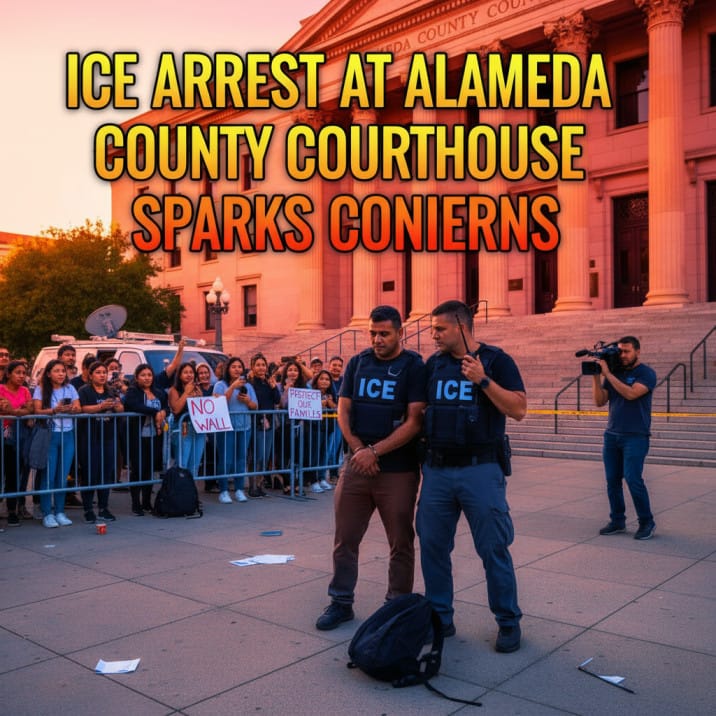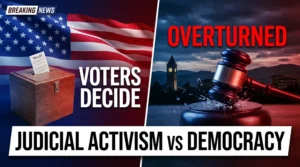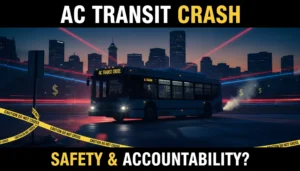ICE Arrest at Alameda County Courthouse Sparks Concerns: What Law, Order, and Community Safety Demand


In mid-September, U.S. Immigration and Customs Enforcement (ICE) agents arrested a man outside a courtroom in Oakland following a routine hearing. According to public defenders, the man had no prior criminal record. Predictably, the incident drew criticism from progressive activists and some local officials, who called the enforcement action near a courthouse “troubling” and “chilling.” But step back from the sound bites, and a clearer picture emerges: this is precisely the kind of lawful, targeted enforcement Congress authorized ICE to conduct, and it’s essential for maintaining the integrity of our immigration system and the safety of our communities.
To understand why, we must separate rhetoric from reality and consider basic principles: the rule of law, equal application of federal statutes, the role of cooperation between local and federal authorities, and the real risks to public safety when immigration laws are treated as optional.
The rule of law is not location-dependent
Critics of courthouse arrests argue that enforcement near judicial facilities might discourage immigrants—documented or not—from coming forward as witnesses or appearing for hearings. It’s a claim often repeated, seldom substantiated, and riddled with selective logic. The judiciary is a core institution where truth is sought and law is administered; it is not a sanctuary from lawful arrest. Courthouses are public spaces where individuals appear under verified identities and verifiable schedules. For that very reason, they are often the safest, most controlled environment for officers to execute civil immigration arrests. The alternative—pursuing targets in homes or on the streets—can increase risks for everyone involved: officers, the public, and the subjects themselves.
Federal agents are not raiding courtrooms mid-trial or disrupting proceedings. The reported arrest in Oakland took place outside the courtroom, after the hearing concluded—precisely the kind of professional, minimally disruptive operation agencies use to avoid chaos and confrontation. If the complaint is that such enforcement chills participation in the justice system, the solution isn’t to carve out broad immunity zones, but to ensure clear communication about how and when federal law applies, and to encourage witnesses and victims—who are already offered special protections in many cases—to engage without fear. Public safety requires both: participation in justice and consistent enforcement of the law.
“Civil” does not mean “optional”
Some defenders say the man had “no criminal record,” implying ICE should have no interest. But immigration enforcement is a civil process governed by federal statute. A civil violation, such as unlawful presence after a final removal order or entry without authorization, does not vanish because there is no state criminal record. The United States maintains sovereign control over its borders and the terms by which foreign nationals may remain. That control means enforcing immigration law consistently—not only when a person commits separate crimes.
Moreover, ICE prioritization has long focused on public safety threats, recent border crossers, and those with final orders of removal. What critics often omit is that courthouse encounters frequently involve people already in the justice system for other reasons, or with pending orders, or with prior immigration encounters. Even when none of those factors are present, ICE has a lawful mandate to identify and remove those without legal status. If we reduce enforcement to only the worst criminal actors, we send a message that violating immigration laws is a risk-free bet unless and until you do something far worse. That’s not a serious policy; it’s an incentive for further disregard of the law.
Local non-cooperation invites predictable outcomes
Sanctuary and “non-cooperation” policies common in parts of California effectively foreclose routine information-sharing with ICE. When local jails refuse detainers or deny notice of release, federal agents must execute more field operations to locate individuals—at homes, workplaces, or yes, courthouses. Critics condemn the symptom while celebrating the cause. If Alameda County and the City of Oakland want fewer ICE operations in public spaces, the fastest path is to cooperate with federal requests inside secure facilities. That’s exactly the environment where handoffs are safest and least disruptive.
Instead, local officials perform a kind of policy theater: passing resolutions that broadcast hostility to federal immigration enforcement and then feigning shock when ICE adapts by using predictable, low-risk locations like courthouses. It is not “troubling” that federal officers carry out their duties. What’s troubling is the deliberate refusal by some jurisdictions to participate in a cooperative framework that protects both due process and public safety.
Courthouse neutrality and selective outrage
We’re told courthouses must remain “neutral spaces.” Agreed. But neutrality is not selective immunity. Law enforcement arrests at courthouses occur all the time—on outstanding warrants, probation violations, or fugitive apprehensions—without generating press conferences and outrage. Singling out ICE, the one agency tasked with enforcing immigration law, reveals the real objection: not the venue, but the enforcement itself.
If a jurisdiction wants fewer federal arrests at courthouses, it could align with lawful detainers, confirm release dates, and facilitate orderly transfers. That approach respects the courthouse as a professional environment while upholding the rule of law. Instead, activists aim to cordon off chunks of public space as de facto sanctuaries—spaces where certain laws are suspended for favored categories. That is a path to fragmentation and arbitrariness, not justice.
Humanity and fairness require clarity, not loopholes
America is a nation of immigrants and of laws. The two are not in conflict unless we make them so. Humane enforcement means predictable rules applied consistently. It means discouraging dangerous smuggling, trafficking, and black-market labor by ensuring that unlawful presence has real consequences. It means trying to prevent families from anchoring their lives to unresolved legal status that could collapse suddenly, as in any enforcement action, because the rules were never regularized. And yes, it means removing individuals who lack a legal right to remain.
Due process is part of this equation. Those apprehended by ICE typically have avenues to seek counsel, contest removal, or apply for relief where eligible—such as asylum, withholding of removal, or protection under the Convention Against Torture. If the Oakland arrestee has viable relief claims, our system allows him to present them. But relief is the exception, not the rule. The integrity of that relief system depends on ICE doing its job to bring cases before immigration courts. Without enforcement, relief becomes a loophole; with enforcement, relief becomes a legitimate safeguard.
Public safety isn’t just about crime statistics
Opponents point out that many ICE targets are not convicted criminals. True, but public safety is broader than conventional crime rates. It includes maintaining an orderly immigration system so that communities are not whipsawed by underground economies, labor exploitation, and the presence of shadow populations beyond lawful oversight. It includes deterring repeat unlawful entries that strain border security and social services. And it includes ensuring that courts—where identities are verified and processes are documented—remain spaces where law is taken seriously, not symbolically.
The real “chilling effect” we should worry about is citizens losing confidence that laws mean anything at all, or that some layers of government can nullify federal statutes they dislike. When that confidence erodes, cynicism grows—and with it, polarization and disregard for all law, not just immigration law.
A better path forward: cooperation, clarity, and consistency
- Restore cooperation between local and federal authorities. Respect lawfully issued ICE detainers where permissible, and coordinate safe transfers in secure settings.
- Reaffirm that courthouses are professional environments, not sanctuaries. Arrests should be conducted without disrupting proceedings, as in the Oakland case.
- Provide transparent information to immigrant communities about due process rights and legitimate relief pathways—without promising immunity.
- Refocus humanitarian resources on orderly legal migration and case backlogs, while maintaining consistent interior enforcement so the system is credible.
- Depoliticize the venue question. The issue isn’t “where” enforcement happens; it’s “whether” we uphold duly enacted laws.
In sum, the mid-September ICE arrest outside the Alameda County courthouse should not be a scandal. It should be a reminder. When localities obstruct cooperation, when rhetoric attempts to create informal immunity zones, and when civil laws are treated as optional until a criminal threshold is crossed, federal enforcement will—and must—adapt. That is not “troubling”; it is the predictable function of a sovereign nation committed to the rule of law.
If America wants fewer courthouse arrests, the answer is not to handicap ICE. The answer is to restore a coherent, cooperative enforcement posture and to insist that our immigration system be both compassionate and credible—where relief exists for the truly eligible, and where the law is applied consistently to everyone else. That is the fair, humane, and conservative approach.












